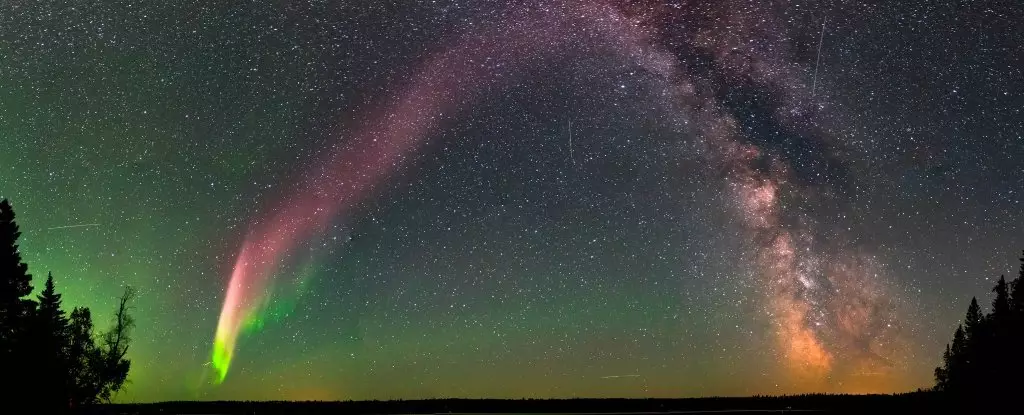When the Sun becomes unruly, Earth witnesses a magnificent spectacle in its sky. Vibrant streams of auroras dance and flicker across the poles, painting the night sky with an array of colors. However, closer to the equator, a different mesmerizing glow emerges – the blushing, mauve-pink STEVE, accompanied by the elusive green-striped picket fence. These atmospheric phenomena have long puzzled scientists, who initially believed they were related to auroras due to their visual similarities. But recent research proposes a groundbreaking idea that challenges this assumption, suggesting that STEVE and the picket fence are distinct phenomena not governed by magnetic fields like auroras, but rather by parallel electric fields at lower latitudes. This revelation could revolutionize our understanding of Earth’s atmosphere, magnetosphere, and the intricate physics involved.
Auroras, undoubtedly one of the most enchanting wonders on Earth, possess a fascinating scientific explanation. These ethereal lights occur when particles from the Sun, propelled by solar winds or eruptions, journey toward Earth. As these particles encounter Earth’s protective magnetosphere, the majority are repelled back into space. However, some particles are captured and directed along magnetic field lines toward higher latitudes, where they collide with atoms and molecules in the upper atmosphere. This collision briefly energizes the atmospheric particles, inducing them to emit a captivating glow. The colors of auroras vary, determined by the specific atoms undergoing ionization. Ionized oxygen emits green light, while nitrogen produces purple or blue hues. Rare instances of an intense solar event give rise to blood-red auroras, which occur at higher altitudes. Amidst these natural wonders is STEVE, a mysterious mauve-and-white apparition often accompanied by the enigmatic picket fence.
STEVE, an acronym for Strong Thermal Emission Velocity Enhancement, was initially recognized as a distinct phenomenon in 2018. Since then, scientists have grappled with unraveling its elusive nature. One prevailing notion was that STEVE was generated by a subauroral ion drift (SAID), a stream of ionized atoms in the upper atmosphere that behaves differently from typical auroral particles. Conversely, the picket fence was thought to result from particles descending from a STEVE. However, the connection between a SAID and the unique glow of STEVE remains uncertain. Additionally, an analysis of the picket fence’s spectrum revealed an unexpected preponderance of green light, without the signature blue of nitrogen ionization. This observation indicated that only electrons within a specific energy range could produce such colors, ruling out the possibility of high-energy particles descending from space into the atmosphere.
In a groundbreaking breakthrough, physicist Claire Gasque and her team at the University of California Berkeley propose an alternative explanation for the picket fence. Their research suggests that the particles responsible for the picket fence’s glow are locally excited by an electric field, distinct from the mechanism behind auroras. This new finding challenges the long-held assumption that the picket fence is an extension of STEVE. Gasque’s team also speculates that a similar process could generate the STEVE phenomenon. To verify this hypothesis, they propose launching a rocket into STEVE or the picket fence to directly study these enigmatic lights. While this endeavor may prove challenging due to the rarity of these phenomena, an alternative approach involves investigating enhanced auroras that display similar colors to the picket fence. These regions of intensified luminosity are believed to be influenced by electric fields and offer a more accessible avenue for further exploration.
If the electric field theory holds true, it would herald significant implications for our comprehension of the intricate interplay between Earth’s atmosphere and magnetosphere. Understanding how these electric fields arise, the waves they are associated with, and their implications for energy transfer could revolutionize our knowledge of Earth’s atmospheric dynamics. However, much remains unknown, and extensive future research is warranted to unravel the complexities surrounding these electric fields and their role in the larger picture.
The mysteries of STEVE and the picket fence lights continue to captivate and challenge scientists. As our knowledge expands, new possibilities and explanations emerge, debunking previous assumptions. The radical proposition that STEVE and the picket fence are driven by electric fields parallel to magnetic field lines instead of magnetic fields themselves offers a fresh perspective on our understanding of Earth’s atmospheric phenomena. While many questions remain unanswered, the quest to comprehend these celestial wonders fuels scientific curiosity and underscores the beauty and complexity of our planet’s relationship with the cosmos.


Leave a Reply